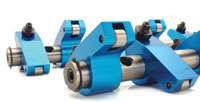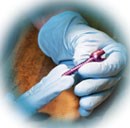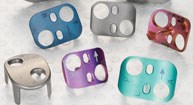Adding Anodizing
Is it something you should consider?
Finishing shops commonly outsource some operations because the envisioned cost and learning curve make it seemingly impractical to bring those processes in-house. They'd rather send such processes to vendors with the expertise and the right equipment while concentrating on their core competency, whether that's plating, paint, powder coating or another type of finishing.
Anodizing is a finishing process that is often performed in shops dedicated (or nearly so) to aluminum finishing. But, could bringing anodizing processes in-house increase opportunities for your business?
Featured Content
One way to set about determining this is to contact a supplier of anodizing systems. The information in this article is provided by such a company, IPEC Global (Rialto, CA). Although this isn't meant to be a "how-to" piece, it does answer initial questions shops often have about the feasibility of adding anodizing to their list of capabilities.
What Is Anodizing?
Most finishers probably have some idea of what anodizing is and how it works, but a bit of background is probably appropriate.
Anodizing is an electrochemical process that speeds the natural oxidation of select non-ferrous materials, primarily aluminum and titanium alloys. It improves surface hardness and wear resistance, and it allows users to manipulate ox
idation thickness. Anodized components are used for a variety of medical, military/aerospace, commercial and automotive aftermarket applications.
Anodizing also lets users change a part's color using dyes (in the case of aluminum) or by manipulating process parameters (for titanium). Color may be added simply for aesthetics or for identification purposes. In medical applications, specific colors may indicate the thread dimension and diameter of, for example, a surgical screw or instrument. This color coding also helps with inventory control, making it unnecessary for hospital employees to be familiar with fastener nomenclature or dimensional identification.
There are three basic types of aluminum anodizing. Type I anodizing, which uses a chromic-acid-based chemical bath, is commonly used for applications that require a thin, protective coating and a high level of corrosion resistance. It also serves as a surface treatment for painting or other coating operations.
Type II anodizing is a common and affordable aluminum anodizing process used on a wide variety of parts. Based on a sulfuric-acid chemistry, it enables parts to be dyed in virtually any color.
Type III anodizing, known as hard-coat anodizing, is used when a very hard surface is needed, such as for weapons, sporting goods and bearing surfaces. The process produces surfaces of varying shades of gray, which are achieved by altering temperature, voltage and bath compositions.
The titanium anodizing process does not involve hazardous chemicals for most applications. And, it's affordable—modular titanium anodizing systems range from $15,000 to $30,000.
After an initial cleaning step, titanium parts are immersed in one of a variety of solutions for anodizing, which creates the oxide film on the surface of the parts. On titanium substrates, the oxide film refracts light in much the same way a thin film of oil refracts light in water. Film thickness can be varied by increasing DC voltage, thus allowing operators to dial-in specific colors. Unlike aluminum anodizing, titanium anodizing does not require color dyes or sealers.
Is It Right for You?
To gage the appropriateness of adding anodizing, a shop should first calculate the amount it currently spends outsourcing the process. If that cost is less than $10,000 annually and you have a reliable vendor, it's generally a good idea to continue outsourcing.
If outsourced anodizing costs as much as $50,000 per year, installing a small, modular anodizing line may make sense. Featuring all necessary tanks, ventilation and waste treatment systems, such systems range in price from $30,000 to $75,000. Permitting for these units typically is not a challenge because the chemical volumes are relatively low and spill containment and fume control are often built into the unit.
Modular anodizing lines are suited for small quantities of parts as large as 2 cubic feet, and typically have a footprint of approximately 20 feet by 8 feet. They are generally manual systems that is, parts are moved manually from tank to tank.
If outsourced anodizing costs your company $150,000 or more, you may want to consider installing a medium- or large-scale modular anodizing line. These systems may use a hoist to move part racks from tank to tank. Costs for a large modular system range from $100,000 to $150,000, and it's recommended that shops contact a consultant to help plan the line design and develop operation manuals.
If a shop's annual anodizing cost exceeds $250,000, modular anodizing systems generally aren't recommended. Tanks, pollution control and other related equipment will be significantly larger than those common in modular systems. Although a custom line might cost $250,000–$500,000, an anodizing cost savings of 50 to 60% is possible. In this case, shops should consult an anodizing expert to develop a preliminary line design before soliciting estimates from potential equipment suppliers.
EH&S Considerations
Operating an anodizing line is similar to operating aqueous cleaning or mass finishing equipment. However, anodizing uses hazardous chemicals, so environmental and worker safety considerations are important. Many finishers are quite used to handling hazardous chemicals, but shops will need to purchase, use and store sodium hydroxide, chromic acid (for Type I anodizing), sulfuric acid (for Type II and III anodizing), nitric acid, ferrous sulfate, nickel acetate and organic dyestuffs. Obviously, employees should be outfitted with the proper protective gear.
Anodizing also generates hazardous waste, including diluted wastes such as rinse water and concentrated wastes from cleaner tanks that need to be removed. Again, many finishers look at waste treatment as simply another part of their business, so if your system has such capacity this may not be a big deal.
The areas of concern are wastewater discharge and air-pollution control. Wastewater from rinsing can be either recycled or sent to the sewer after treatment. Adequate ventilation is also necessary, and most modular anodizing units have integral ventilation hoods. Anodizing fumes must be exhausted outside the facility, so a corrosion-resistant exhaust fan and ducting are needed. Type I anodizing emits chromic acid fumes, and most government agencies will require a fume scrubber. Scrubbers may not be required for Type II or III anodizing.
Again, modular, self-contained lines are generally easier to permit than large lines. Shops considering a large line should plan on spending more time and money on engineering and permits.
Depending on your locale, permits may be submitted to the local fire department for final approval. Fire codes tend to focus on chemical containment and storage in addition to fume exhaust, ventilation and fire sprinkler systems. Some fire departments require an extensive ventilation system with emergency generators and fire sprinklers installed within the duct work for large anodizing lines. This most likely will not be required for smaller modular systems.
Part Size Considerations
Part size is another factor in determining if anodizing is appropriate for your shop. Large anodizing systems can take up significant floor space, while modular systems tend to have relatively small footprints. In some cases you may want to continue to outsource large parts and process smaller ones in-house.
Regardless of system details, shops that bring anodizing in-house should expect to encounter some problems during the learning, installation and start-up phases of the process.
You'll need to locate chemical suppliers, and you may also need to purchase racks or masking materials. Simply put, anodizing lines, even small ones, are not "plug-and-play." However, investing time and effort early in the planning stage will result in an anodizing process that is as effective as it is easy to maintain and operate.
RELATED CONTENT
-
How to Apply the 720 Rule to Current Density Anodizing
What can you tell me about the 720 Rule as it applies to current density anodizing? Plating expert Sjon Westre, Ph.D., from Chemeon, answers this question.
-
Understanding Corrosion and Salt Spray
How it’s produced, NSS testing and how to get the best results possible.
-
Test Methods For Evaluating Anodized Aluminum
Benefits of anodizing include durability, color stability, ease of maintenance, aesthetics, cost of initial finish and the fact that it is a safe and healthy process. Maximizing these benefits to produce a high–performance aluminum finish can be accomplished by incorporating test procedures in the manufacturing process.


.jpg;width=70;height=70;mode=crop)



















